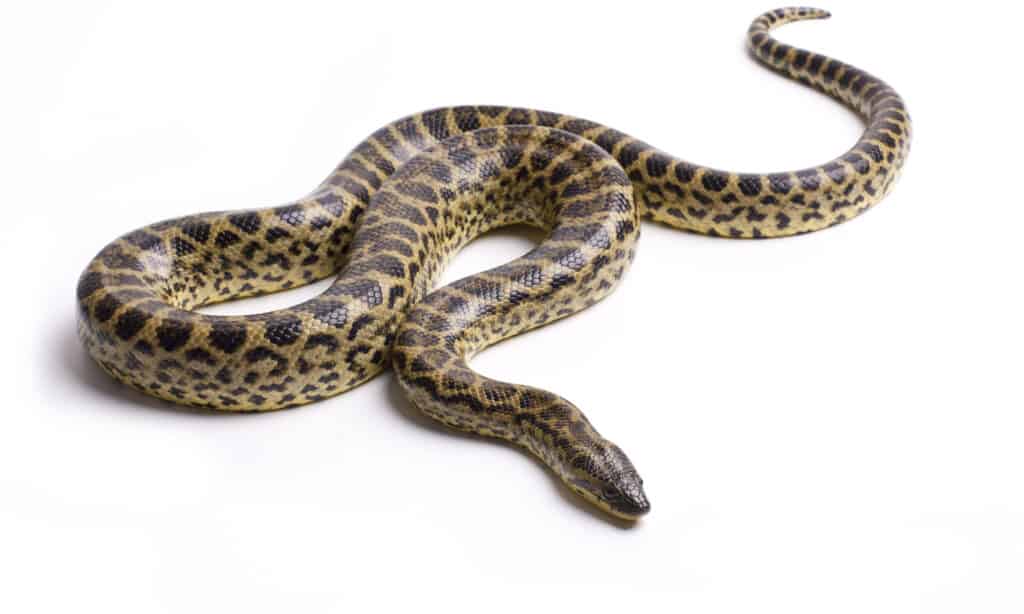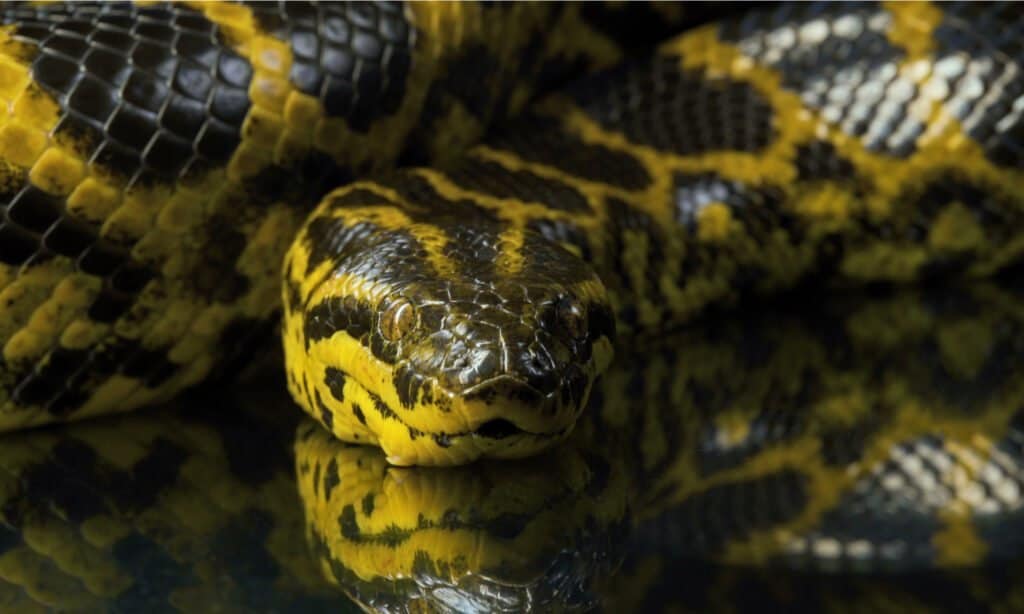Yellow Anaconda
E. notaeus
Anacondas take prey much bigger compared to body weight than other snakes.
Advertisement
Yellow Anaconda Scientific Classification
- Kingdom
- Animalia
- Phylum
- Chordata
- Class
- Reptilia
- Order
- Squamata
- Family
- Boidae
- Genus
- Eunectes
- Scientific Name
- E. notaeus
Read our Complete Guide to Classification of Animals.
Yellow Anaconda Conservation Status
Yellow Anaconda Facts
- Prey
- capybara, peccaries, caimans, fish, birds, small deer
- Name Of Young
- Neonates
- Group Behavior
- Solitary
- Fun Fact
- Anacondas take prey much bigger compared to body weight than other snakes.
- Biggest Threat
- People hunting them for skins and in retaliation for livestock predation
- Distinctive Feature
- Dorsal blotches, noticeably yellow base color
- Other Name(s)
- Paraguayan anaconda, yakumama, matatoro, sucuri
- Gestation Period
- About 6 months
- Temperament
- Apt to bite
- Litter Size
- 20-40
- Diet for this Fish
- Carnivore
- Lifestyle
- Nocturnal
- Common Name
- Yellow Anaconda
- Origin
- South America
- Average Clutch Size
- -2
Yellow Anaconda Physical Characteristics
- Color
- Brown
- Yellow
- Dull Olive
- Skin Type
- Scales
- Lifespan
- 15-23 (longer in captivity)
- Weight
- Adults weigh 55-80 pounds
- Length
- 10-15 feet
- Age of Sexual Maturity
- 3-4 years
- Venomous
- No
- Aggression
- High
View all of the Yellow Anaconda images!
Yellow anacondas are generalist carnivores and will eat anything they can overpower with their massive size and strength.
These are large snakes in the boa family that live in South America. While not as well-known as the even bigger green anaconda, these snakes achieve lengths of up to 15 feet long and 80 pounds.
Amazing Facts About Yellow Anacondas
- Many people keep yellow anacondas as pets and say they’re more “bitey” than other snakes.
- Females don’t lay eggs, they give birth after the eggs develop inside their mom’s body for 6 months.
- Yellow anaconda adults have few natural predators, but juveniles are often eaten by bigger carnivores, even adult yellow anacondas have been known to eat them.
Yellow Anacondas: Where Can You Find Them?
The yellow anaconda is endemic to South America in marshlands and swamps of the Paraguay River and its tributaries in Bolivia, Paraguay, western Brazil, northeastern Argentina, and possibly northern Uruguay. It prefers mostly aquatic habitats and avoids dry areas. There may be a population in southern Florida, but it’s unclear whether it’s breeding; these snakes are present in the area thanks to people who illegally release their pet anaconda when it gets too big.
This species spends most of its time in or near the water, actively foraging or waiting to ambush its next meal. The yellow anaconda eats a wide variety of prey animals including mammals, birds, reptiles, amphibians, fish, and eggs. It is capable of taking much larger prey than other Boidae species and bigger snakes can eat larger animals such as capybaras, peccaries, or caimans. There may be some cannibalism, but no one knows how prevalent the behavior is.
While it moves slowly on land, it is quick and agile in the water. Anacondas that live in areas with seasonal flooding and dry periods must stay wet, and they do this by burrowing into the mud. Yellow anacondas usually mate between April and May; the female carries the babies for about 6 months until they are born.
Adult yellow anacondas don’t have many natural predators, but juveniles and the occasional adult may be taken by caimans, jaguars, cougars, and other larger predatory animals.
Scientific Name of the Yellow Anaconda
The yellow anaconda’s scientific name is Eunectes notaeus. Anacondas are part of the Boidae family and cousins to boa constrictors. Eunectes means good swimmer, and notaeus is a Latin synonym for dorsal because its dorsal blotches (on the back) are different than that of the green anaconda.
Yellow anacondas have several names. They’re often called the Paraguayan anaconda; another name, matatoro, is a Spanish term that means bull killer. However, Native American terms include sucuri and yakumama. They’re also called water boas; an accurate term reflecting their preferred habitat and status as boa family members.
Yellow Anaconda Population and Conservation Status
Yellow anacondas are common in their native habitats in Brazil, Bolivia, Paraguay, and northern Argentina. They’re rare in Uruguay, where scientists haven’t fully ascertained whether there’s a breeding population. This snake has a stable population in its home range, and they’re categorized as Least Concern on the IUCN Redlist. In 1997, the Convention on International Trade in Endangered Species of Wild Fauna and Flora (CITES) recommended that the export of their skins be halted, but otherwise, they’re not protected.
Even in areas where people have harvested the species heavily for its skin, their population appears unaffected. This leads researchers to believe that in suitable areas, they achieve a relatively high population density.
The wet, subtropical ecosystem in Florida is prime habitat for this water-loving snake. As a result, released anacondas can become a problem. Florida Fish and Wildlife considers the introduced anacondas invasive and actively captures them to remove them from the environment. They even have a special phone number to call to report a sighting.
Identifying Yellow Anacondas: Appearance and Description
This is a large snake, second only to the green anaconda in weight. The yellow anaconda has a noticeably yellow base color, which can vary between greenish-yellow and brownish-yellow. Over the base color are dark blotches that are typically dark brown to black.
Its head is blunt, like other boa family snakes, and its eyes and nostrils are more towards the top of its head. It has elliptical pupils, and stripes that start right behind its eyes and extend towards the back of its head. Its teeth are curved inwards to move prey into its throat, and it has dozens of razor-sharp teeth.
This species is sexually dimorphic and the females grow much longer and heavier than the males. Females can reach 15 feet long and 80 pounds, while the males typically only reach about 10 feet long and approximately 50 pounds.
Yellow anacondas are cousins of boas and constrict their prey until it stops breathing. They have powerful jaws capable of holding their prey while their muscular body coils around it and squeezes.

Yellow anacondas are huge constrictor snakes.
©cellistka/Shutterstock.com
Pictures and Videos of Yellow Anacondas

Yellow anacondas aren’t great pets and can be aggressive.
©cellistka/Shutterstock.com

Yellow anaconda closeup
©Chris Tefme/Shutterstock.com
How Dangerous are Yellow Anacondas?
This is a pretty aggressive species, and it is happy to bite if it thinks you’re a threat. Or if it just doesn’t want you near it. In some parts of the U.S., selling them across state lines is illegal, and in Florida, they’re illegal to own without a permit.
The good news is that they’re not venomous, so you’re not likely to die or need medical care from a yellow anaconda bite. However, a larger anaconda that decides you are a threat will bite repeatedly; if you continue to hold it, that anaconda will most likely coil around you and squeeze. If it goes on too long, the animal can easily break human bones.
Yellow Anacondas Behavior and Humans
In the wild, these snakes avoid human contact. They’re relatively shy and don’t want anything to do with people. However, yellow anacondas are highly defensive and will repeatedly bite to make you back off from them. These snakes are large predators with slow metabolisms that allow them to wait weeks and sometimes months between meals, depending on the size.
Yellow anacondas (and anacondas in general) are frequently seen as a threat to human and livestock life. So, locals often kill the larger specimens as a preventive measure. As people encroach further into areas where they live, encounters are more likely to occur, and the anacondas are often the losers.
View all 32 animals that start with YYellow Anaconda FAQs (Frequently Asked Questions)
Are yellow anacondas venomous?
No, like all boa cousins, anacondas kill their prey by constriction, not venom.
Are yellow anacondas aggressive?
Yes, in captivity. In the wild, they’re rather shy and more likely to flee.
What do yellow anacondas eat?
These are generalist feeders – they’ll essentially eat anything they can overpower. As juveniles, that means mostly fish, birds, and small mammals. As adults, that can mean larger animals like capybaras and even caimans.
How do yellow anacondas hunt?
They’re primarily ambush predators and prefer to hide just under the water line, waiting for a meal. However, they’re opportunistic and actively forage also.
Thank you for reading! Have some feedback for us? Contact the AZ Animals editorial team.
Sources
- Tropical Conservation Science, Available here: https://tropicalconservationscience.mongabay.com/content/v9/tcs_v9i1_43-77_Miranda.pdf
- Yellow Anaconda | IUCN Redlist, Available here: https://www.iucnredlist.org/species/44580058/44580062
- CITES, Available here: https://cites.org/eng/node/2407

















